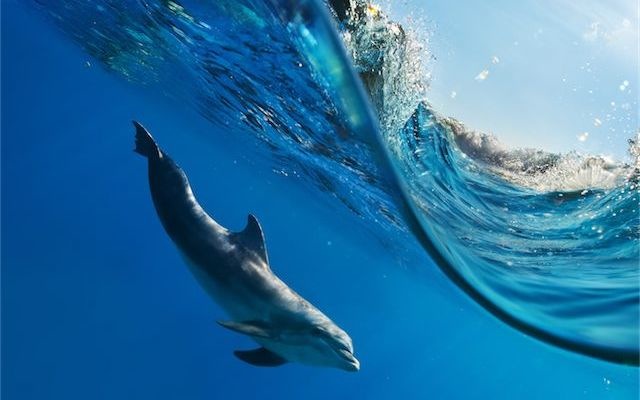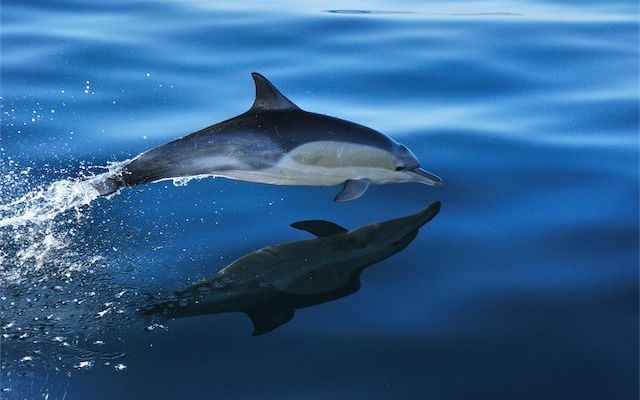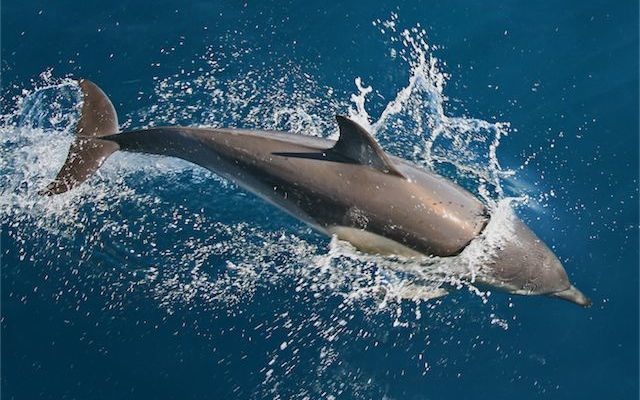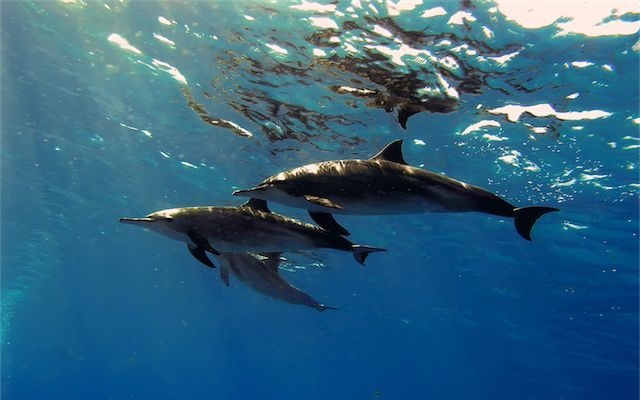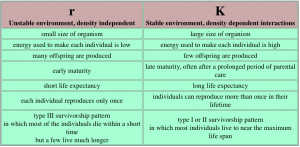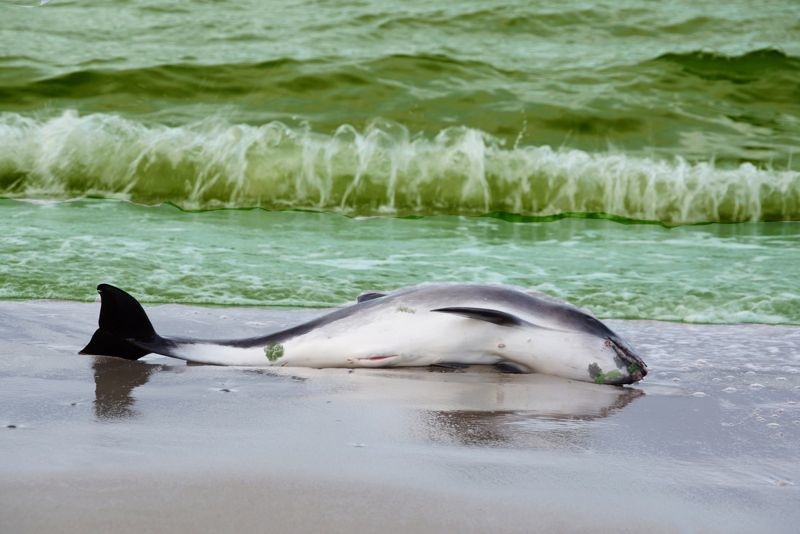AcidSeas – Near-term dolphin extinction from CO2 Acidification and Food Web Collapse
It’s terrible but true. If the seas acidify to the point of food web collapse, long-lived top carnivores like dolphins cannot be expected to survive.
Once the calcium carbonate dissolves from the seas, there will be huge and rapid changes.
The Species which survive that kind of change are the high-reproducing opportunists like jellyfish.
There are many dangers dolphins face right now… direct kills, sold as fake whalemeat, entangled in invisible gillnets, targeted by tuna purse-seine vessels, harpooned as crab and shark bait, assaulted by the sounds of human industry and military sonar, poisoned by human industrial and agricultural effluent, starved as humans compete with them for food in the seas.
Taken together, these constitute a nearly overwhelming challenge to dolphin survival, which is why we have fought to overcome that challenge for over 30 years. We’ve succeeded, in that as of now there are still dolphins in the seas, even if at nothing like their historic populations.
However, there is an existential danger to dolphins which could make their survival literally impossible: the killing of the seas as humans have always known them, though acidification and heating.
Within many nations, in particular the USA, there have been campaigns of obfuscation funded by CO2-emitting industries causing many people to disbelieve that CO2 causes heating of the planet’s atmosphere and oceans. Although the science has been well-understood since the 1800’s, the time lag for greenhouse heating of the biosphere is long enough that most people choose to ignore it.
But the heating of the biosphere – as dangerous as that is – isn’t the most serious effect. The most serious and immediate effect of burning millions of years of fossil carbon is to acidify the seas – turn them more acidic. The seas are already 30% more acidic than they have been since humans evolved, and by the end of this century they are predicted to be 170% more acidic.
This fact – which is hugely more dangerous to the world and human interests than the much-touted “sea level rise” – has sobering implications. At that level of acidity, calcium carbonate will fizz away and be unavailable for use by animals. Coral reefs will dissolve and not come back for millions of years. The calcareous skeletons of plankton organisms will fail to form. Huge holes will be knocked in oceanic food webs, consigning a high percentage of living species to extinction.
And if the destruction of food webs wasn’t enough…
Scientists have just started to uncover the devastating effects of more acidic seas. Here are a few of their findings and predictions. Please keep in mind that very little research has been done. This is just the beginning of understanding the devastating effects that rapidly changing the acidity of the seas is causing..
This is a crisis which has not yet hit the threshold of dissolution for aragonite and calcite in most parts of the seas: that will be locked in with several more decades of business as usual carbon burning, and at that point will be essentially permanent on any scale relevant to human existence.
Changing the acid balance of the seas is probably causing millions of subtle changes which will never be researched. How could it not? The electrochemistry of life, the very creation of calcium structural parts, is affected. Never in the history of life have the seas acidified this fast, even during past mass extinction calamities.
However, effects that are already being seen due to the Increasing Acidification of the oceans includes:
- Algae – Coraline algae has already declined by 92% in acidic areas (1)
- Cobia – a popular game fish grows larger ear bones in acid water – which may disrupt the detection of useful auditory information (3)
- Corals- Larval corals of many species cannot find areas to settle in die off. (1)
- Clownfish – go deaf in acid water and can’t hear predators coming (1)
- Clownfish – can’t find their way back home in acid water (4)
- Fish – the blood of fishes changes pH resulting in acidosis which depletes them of the energy needed to thrive (1)
- Foraminifera – ( a species of zooplanckton- tiny organisms that are the critical to healthy oceans ) – their shells are dissolving in acid seas (6)
- Jellyfish – appear to thrive in acid seas and are beginning to dominate some ecosystems (1)
- Mussels- cannot cling by their byssal threads to rocks in the pounding surf very well in acid seas (1)
- Oysters – Larvae are failing to grow their shells as the acid seas eat away the shell layers before they can finish laying them. This has caused massive oyster die offs in the Pacific Northwest (1)
- Sea Snails (pteropods) – shells are dissolving in the Southern Ocean (1)
- Urchins – larval urchins have trouble digesting their food in acid seas (7)
Predicted Effects on cetaceans:
Dolphins and whales – Eventual Extinction. Eventually, after their food sources die off dolphins and whales will too.
Near-term effects until Extinction:
Dolphins and Whales – Deafness. Sound travels farther in acidic seas. Whales and dolphins could effectively “go deaf” and not be able to distinguish sounds used to navigate and find prey. (5) Note: Some scientists point out that the increase in sound theoretically will not be enough to affect whales and dolphins who are already affected by very loud shipping lanes and other man-caused noises. We do not find this reassuring.
Dolphins and Whales – Starvation. As OA increases, it will disturb the food chains that apex marine species depend on . Leading eventually to extinction.
Other Marine Species:
* Coral Reefs- many species will become weakened and vulnerable to predation and may dissolve, thus threatening the ocean ecosystems that depend on corals to be an important base of ocean food chains. (1)
* Foraminifera that live in tropical seas are predicted to become extinct by 2099 (6)
* Jellyfish – may be one of the few species to thrive in acid seas will out compete other predators, such as zooplanton and will eat baby fish (1)
* Mussels and oysters are expected to grow less shell by 25 percent and 10 percent respectively by the end of the century. (1)
The above are just a few of the known and potential effects. Scientists are continuing to uncover new, devastating consequences of man heedlessly allowing the oceans to be destroyed.
– Sharon White, Program Director, Flipper Fund
sources:
(1) http://ocean.si.edu/ocean-acidification
(2) http://e360.yale.edu/feature/northwest_oyster_die-offs_show_ocean_acidification_has_arrived/2466/
(3) http://www.rsmas.miami.edu/news-events/press-releases/2013/ocean-acidification-as-a-hearing-aid-for-fish
(4) http://www.scientificamerican.com/article/ocean-acidification-can-m/
(5) http://scienceray.com/earth-sciences/increased-acidity-can-be-deafening-sea-dolphins/
(6) http://www.nature.com/srep/2013/130503/srep01769/full/srep01769.html/131116
(7) (http://www.natureworldnews.com/articles/4948/20131116/oceanic-acidification-ruining-digestion-sea-urchins.htm
Recommended reading…
Here are a few links you should check out…
Modern Ocean Acidification Is Outpacing Ancient Upheaval, Study Suggests
What do we mean by “Near-term Dolphin Extinction”?
This is a reality which is only now becoming clear. The conservative scientific way to state it is to say that there is no reason to think that long-lived species at the top of the food chain, with very low reproductive rates and high reliance on existing food webs, will survive the utter collapse of ocean food webs which will occur if aragonite and calcite are removed from the seas as structural materials for plankton, molluscs, arthropods, shellfish, and many other classes of organism that are utterly basic to existing food chains from the bottom up.
It might well take several hundred years for marine dolphins to become extinct. (Or it might not.) What’s near-term about that? Well, it’s an eye-blink in evolutionary time. But more importantly, the levels of acidification which will “lock in” these food web changes will occur in the next several decades, and will get steadily worse as long as fossil carbon burning persists. A person 50 years old today could easily live well past the dooming of the dolphins.
What is our plan to save them?
Here’s the thing. All the stuff that we need to do anyway to prevent CO2 from devastating the climate, destroying rainforests, melting polar ice and consigning our grandkids to a hundred thousand years of Hell on Earth…. we need to do it sooner.
Unlike the arbitrary notion, debated with assumed authority by cabdrivers and politicians, that some level of CO2 pollution like 350, 400, 450, or 500 parts per million “might be safe” for climate, there are absolute thresholds of doom in the seas. When the water gets too acidic for organisms to precipitate out aragonite, those organisms disappear. When it gets a bit more acidic, the organisms that use calcite disappear. Period. Life can evolve to deal with a lot, but no organism which has ever existed could evolve away from needing a skeleton in a hundred years. Certainly not one you could see without a magnifying glass.
Here’s the deal: the dolphins, whales, seals, penguins, etc are the new face of CO2 pollution. We’re making the point with Dolphins, since we’re dolphin-saving experts.
There’s no longer any rationale for arm-waving. If we continue to burn coal, we return the seas to primordial slimy conditions. Without dolphins.
We need to make the hard choices, because there’s pretty much no time to spare. Again: all that stuff we need to do to keep our grandkids, and their grandkids, from suffering? We need to do all that stuff sooner for the dolphins.
And just maybe, doing it sooner will make our grandkids’ lifes better too… in addition to not having to carry the burden that their people killed the living seas.
The Campaign is Just Getting Started…
And already time is short.
We’re talking about pretty hard-core “end of growth” stuff. Reversing the industrial inertia and powering down the fossil carbon economy. It won’t be easy. Some people think the stock market is more important than are living seas.
What we have to offer is a clearer vision of the stakes and the timetable. Forget global heating: it’ll take care of itself if we save the seas from acidifying.
So let’s all take a giant step away from the psuedo- “debate” on the facts of greenhouse heating, and take two giant steps away from “adapting” to high CO2 conditions. We have no moral right to ‘adapt’, and our air conditioners won’t work for more than 100 or so years of the next hundred thousand years of heat anyhow.
We need to save the seas. Killing off large sea life for a million years, to keep the economy booming for a few more decades is Evil, with a capital E.
We propose to stand against that evil, in the most creative ways we can think of. If you’d like to stand with us, we welcome you.




